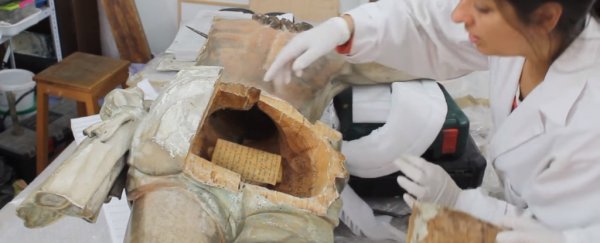A priest in 18th century Spain found a clever niche to hide a secret message to the future - in the derriere of a hollow statue of Christ crucified, called Cristo del Miserere.
The statue had been removed from the church of Santa Águeda in Sotillo de la Ribera for restoration, and it was conservators at the restoration company who found a hidden document when they took out a removable piece of the wooden statue - the cloth that covers the buttocks.
And it seems to be an actual "time capsule" - intended to remain hidden for hundreds of years, and a very peculiar and interesting find.
"Although it is usual for many sculptures to be hollow," explained historian Efrén Arroyo, and member of the Holy Week Brotherhood of Sotillo de la Ribera, "it is not so much to find handwritten documents inside."

The note, covering both sides of two pieces of paper, was authored by Joaquín Mínguez, a chaplain of the Cathedral of the Burgo de Osma, in 1777.
In it, he documents the sculptor of the statue, Manuel Bal, "natural scholar of San Bernardo de Yagüe and neighbor in Campillo, both of this Bishopric of Osma," and notes that Bal carved five other statues for the main altar of the church of Sotillo de la Ribera - Santa Águeda and the saints Santiago, Millán, Jerónimo, and Juan.
But that's not all he included in the note. He also wrote about life at the time - including the name of the king, Carlos III, various aldermen and events of the time.
He detailed the crops cultivated in the region (wheat, rye, barley and oats, and wine grapes); the most common diseases (such as malaria and typhoid fever); and the most popular entertainments of the population (such as cards, ball games, and bar games).
He even gives more general information.
"The Court is in Madrid, there is a Mail and Gazette for the news, there is an Inquisition, for which no errors are experienced against the Church of God," the document reportedly reads.
According to Arroyo, these details strongly indicate that Mínguez deliberately wanted to leave a snapshot of the time for posterity.
It may seem an unusual place to look for artefacts, but religious statues are proving to be quite interesting in that regard.
In 2014, an 18th century statue of Christ from Mexico was found to have human teeth in its mouth, and in 2015, researchers announced they'd found the body of a mummified monk inside a 1,000-year-old Chinese Buddha statue.
This, however, may be the first time a holy butt has been used as a keeping place for a time capsule.
The original document has been sent to the archives of the Archbishopric of Burgos for safekeeping, but a copy has been made and put back inside the statue to continue fulfilling Mínguez's intentions.
